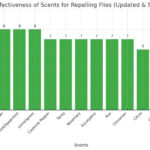Dealing with those tiny buzzing pests in your kitchen? You might have fruit flies! Don’t worry. These common annoyances are easily eliminated with simple, cost-effective solutions. At flyermedia.net, we’ll explore proven methods and preventative measures to keep your home fruit fly-free. Let’s explore fruit fly control and fruit fly prevention with home remedies.
1. What Exactly Are Fruit Flies?
Fruit flies are small flying insects attracted to sweet fruits and fermenting substances. They are scientifically known as Drosophila melanogaster. They thrive on ripened or decaying produce, sugary spills, and even fermented beverages. You’ll often find them buzzing around fruit bowls, garbage cans, and sink drains. They’re tiny, typically tan or brownish, and have distinctive red eyes. Fruit flies commonly appear during warmer months when fruits are abundant.
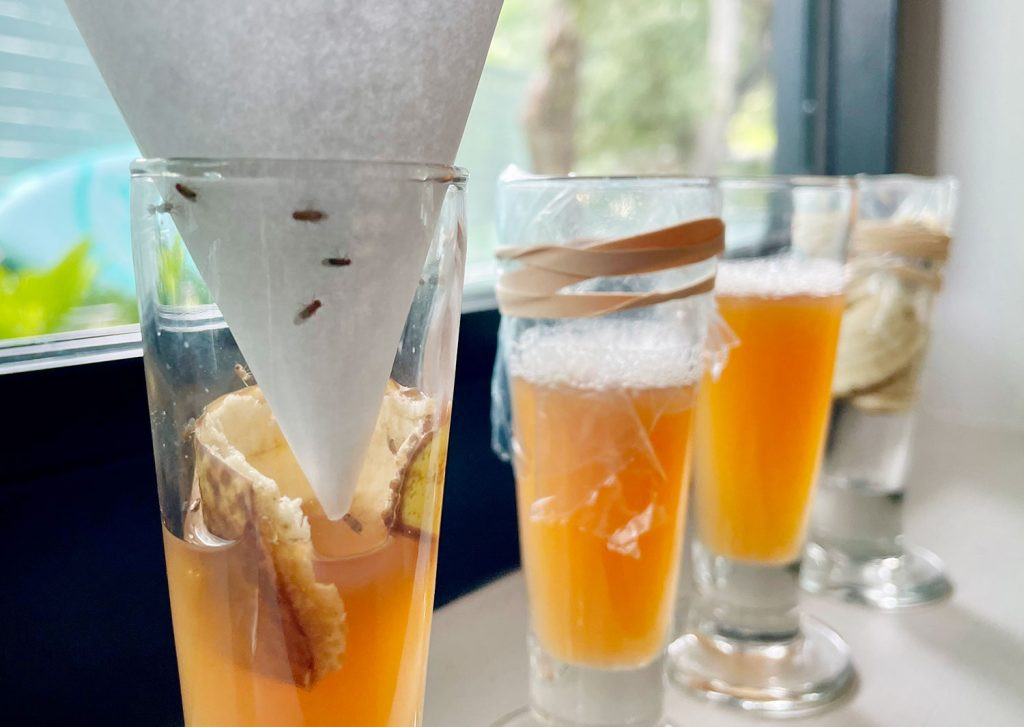 Fruit Flies Trapped In DIY Funnel Trap Method
Fruit Flies Trapped In DIY Funnel Trap Method
1.1 Why Are Fruit Flies So Annoying?
Fruit flies reproduce quickly, with females laying hundreds of eggs in their short lifespan. These eggs can hatch in as little as 24 hours, leading to rapid population growth. A few fruit flies can quickly turn into a frustrating infestation. The National Pest Management Association emphasizes that swift action is crucial to prevent an infestation.
1.2 How to Identify Fruit Flies
It’s easy to confuse fruit flies with other small insects like fungus gnats and drain flies. The key is to observe where you find them and what they resemble.
| Insect | Appearance | Habitat |
|---|---|---|
| Fruit Flies | Small flies, tan or brownish | Near fruit, trash, sugary spills |
| Drain Flies | Small, fuzzy moths | Near sinks and drains |
| Fungus Gnats | Small mosquitoes | Near houseplants, damp soil |
If you’re unsure, setting up a simple trap can help you identify the culprit.
2. DIY Fruit Fly Traps: Simple & Effective
Getting rid of fruit flies doesn’t require expensive solutions or professional help. Common household supplies and a bit of patience are often enough. The basic principle of a fruit fly trap is to attract the flies and prevent their escape. Here are some DIY methods to try:
2.1 The Funnel Trap
This trap uses a paper funnel to guide fruit flies into a container, making it difficult for them to escape.
 4 DIY Fruit Fly Traps Tested On Windowsill
4 DIY Fruit Fly Traps Tested On Windowsill
Supplies:
- Small clear jar or container
- Paper or cardstock
- Tape
- Scissors
- Apple cider vinegar (ACV)
Instructions:
- Choose a container: A small, clear container with a narrow opening works best.
- Add ACV: Pour a small amount of apple cider vinegar into the container.
- Make a funnel: Roll a piece of paper into a cone shape with a tiny opening at the tip and secure it with tape.
- Set the funnel: Place the funnel into the container opening, ensuring it doesn’t touch the ACV and that there are no gaps for escape.
2.2 The Plastic Wrap Trap
This trap uses plastic wrap with small holes to trap fruit flies.
Supplies:
- Small clear jar or container
- Rubber band
- Plastic wrap
- Toothpick
- Apple cider vinegar (ACV)
Instructions:
- Choose a container: Use a small, clear jar or container.
- Add ACV: Pour apple cider vinegar into the container.
- Cover with plastic: Stretch plastic wrap tightly over the opening and secure it with a rubber band.
- Poke holes: Use a toothpick to poke a few small holes in the plastic wrap.
2.3 The Dish Soap Trap
This trap uses dish soap to disrupt the surface tension of the liquid, causing fruit flies to drown.
Supplies:
- Small container, bowl, or dish
- Dish soap
- Apple cider vinegar (ACV)
Instructions:
- Add ACV: Fill the container with apple cider vinegar.
- Add dish soap: Add several drops of dish soap and mix gently.
2.4 The Rotting Fruit Trap
This trap uses overripe fruit to attract fruit flies.
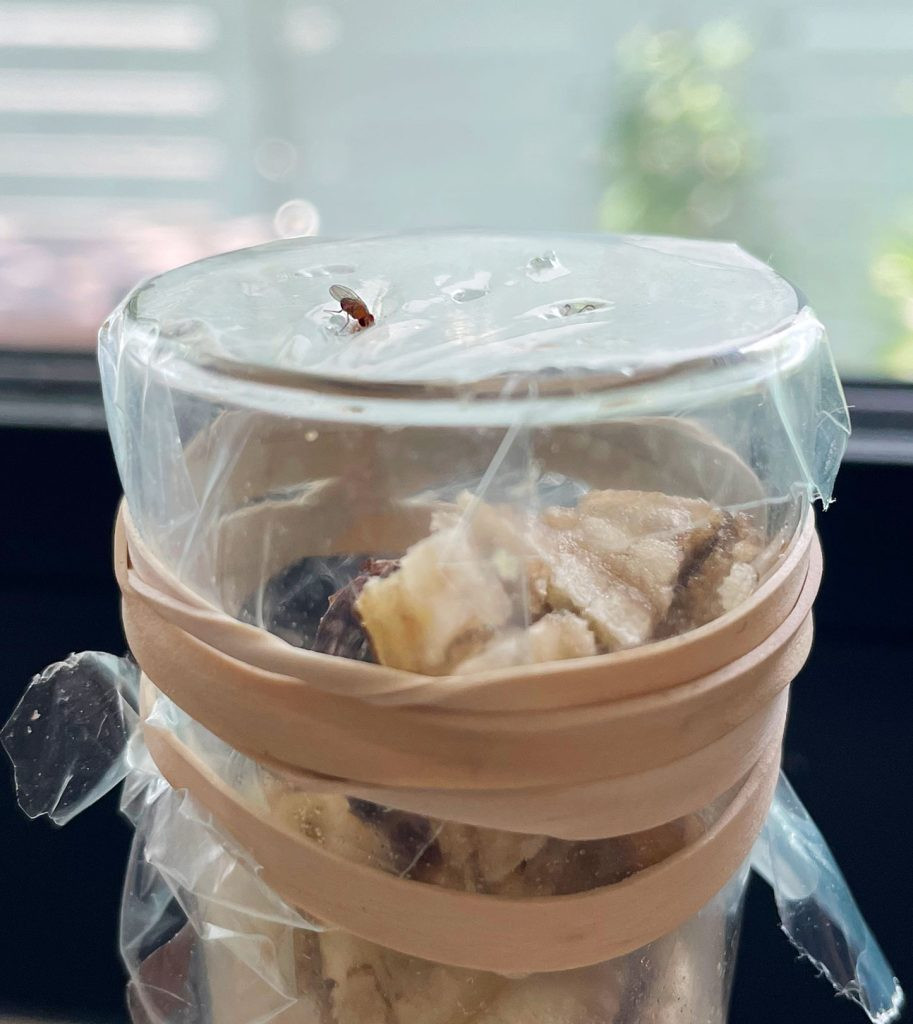 Fruit Fly Entering Plastic Wrap On DIY Trap
Fruit Fly Entering Plastic Wrap On DIY Trap
Supplies:
- Small jar or container
- Plastic wrap or paper funnel
- Overripe fruit (banana peel, apple slice)
Instructions:
- Add fruit: Place a piece of overripe fruit in the container.
- Cover: Cover the container with plastic wrap and poke holes, or use a paper funnel.
2.5 Which DIY Trap Works Best?
In tests, traps using banana peels performed exceptionally well. While apple cider vinegar is effective, fruit flies seem more attracted to actual fruit. For optimal results, add a fruit scrap to any of the traps above. The plastic wrap trap is generally preferred due to its ease of construction and stability.
3. What Lures Fruit Flies Most Effectively?
To determine the best bait, test different types of fruit. Place banana peels, apple slices, and strawberries in separate plastic wrap traps and observe which one attracts the most flies. Strawberries tend to be highly effective as they rot, although results may vary.
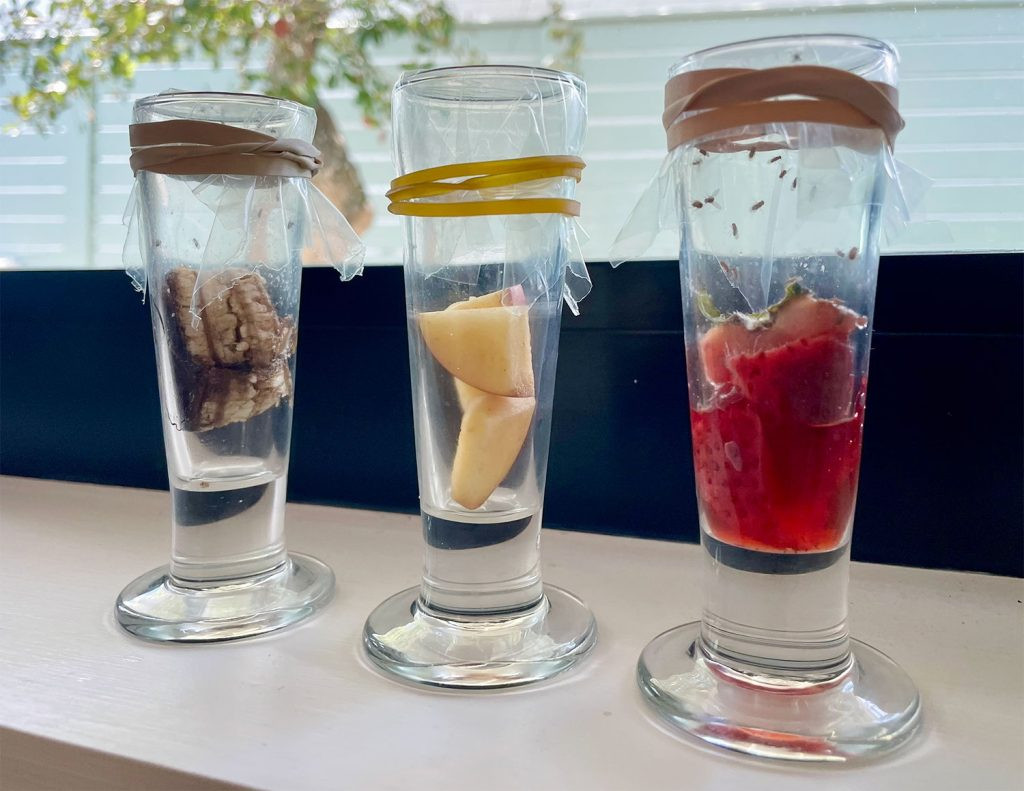 Fruit Fly Traps With Different Rotten Fruit Baits
Fruit Fly Traps With Different Rotten Fruit Baits
4. Store-Bought Fruit Fly Traps
If DIY traps aren’t working or you prefer a more convenient solution, several effective store-bought traps are available. These traps are designed to be discreet and can catch various flying insects. Terro traps are a popular option. While homemade traps often work faster, store-bought traps can be effective over time.
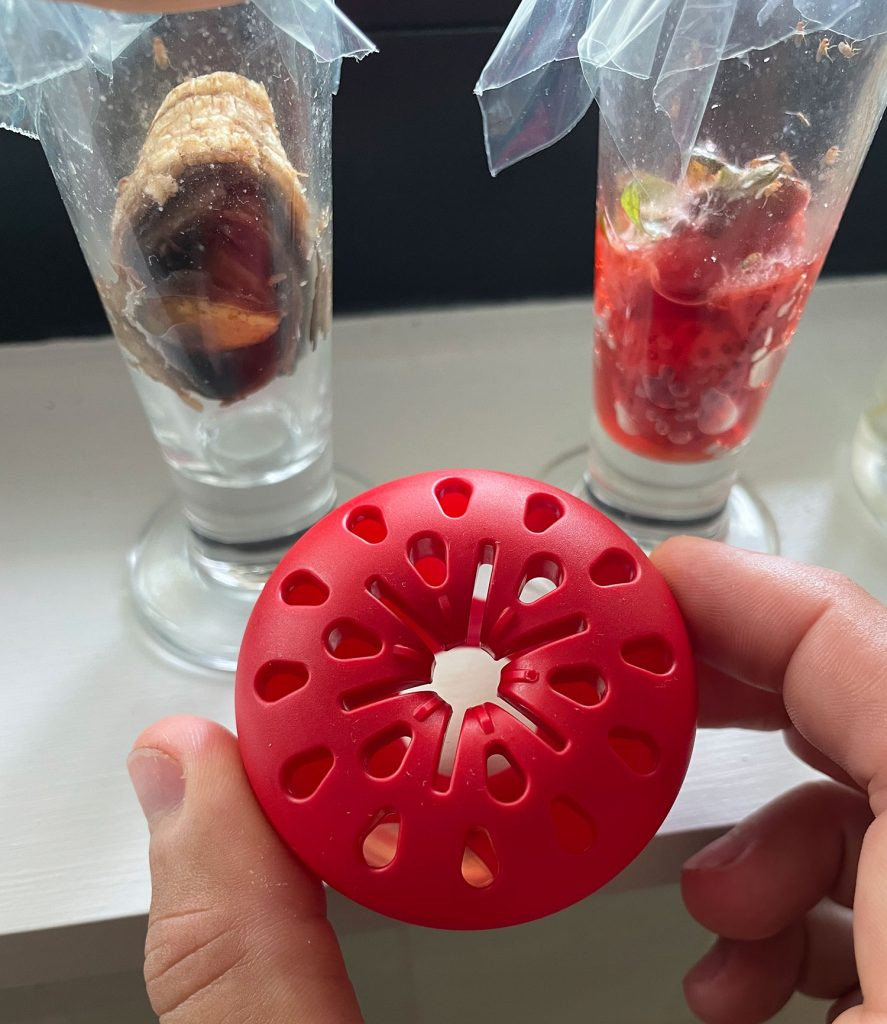 Terro Fruit Fly Apple Trap With No Fruit Flies In It
Terro Fruit Fly Apple Trap With No Fruit Flies In It
5. How Can I Prevent Fruit Flies?
Preventing fruit flies is the most effective way to manage them. Here are some preventative measures:
5.1 Maintain Clean Surfaces
Wipe down kitchen counters, stovetops, tables, and other surfaces to remove food residue and spills.
5.2 Regularly Empty the Trash
Food scraps in the garbage can create a breeding ground for fruit flies.
5.3 Dispose of Overripe Fruit
Monitor fruit bowls and discard browning or rotting fruit.
5.4 Wash Produce Immediately
Washing produce as soon as you bring it home can eliminate any eggs or larvae. However, wash berries right before consuming.
5.5 Store Produce in the Refrigerator
Fruit flies are less active in cold environments.
5.6 Keep Drains Clean
Food scraps in sink drains attract fruit flies. Regularly flush drains and use a garbage disposal.
According to a study by the University of California, Davis, maintaining a clean kitchen environment significantly reduces the likelihood of fruit fly infestations.
6. Understanding Fruit Fly Behavior
To effectively combat fruit flies, understanding their behavior and habits is essential. Here are some key aspects of their biology:
6.1 Life Cycle
Fruit flies have a rapid life cycle, which contributes to their ability to quickly infest an area. The life cycle consists of four stages:
- Egg: Female fruit flies lay their eggs on or near the surface of fermenting fruits or other organic matter.
- Larva: The eggs hatch into larvae (maggots) that feed on the decaying material.
- Pupa: After several days, the larvae transform into pupae, which are small, brown, and immobile.
- Adult: The adult fruit fly emerges from the pupa, ready to reproduce and continue the cycle.
This entire life cycle can be completed in as little as 8 to 10 days under optimal conditions, as noted by the USDA.
6.2 Attraction to Fermentation
Fruit flies are highly attracted to the odors produced by fermentation. This is why they are commonly found near:
- Overripe fruits and vegetables
- Fermenting beverages like beer, wine, and cider
- Pickling and canning operations
- Any area where sugary substances are left to spoil
6.3 Flight Range and Dispersal
While fruit flies are not strong fliers, they can travel a considerable distance to find food sources. They typically fly within a range of several hundred feet from their breeding site. According to research from Embry-Riddle Aeronautical University, in July 2025, they can also be carried by air currents, which can lead to them appearing in unexpected places.
6.4 Seasonal Activity
Fruit flies are most active during the warmer months, from late spring through early fall. This is because the higher temperatures accelerate their life cycle and increase the rate of fermentation, making food sources more attractive.
7. Additional Tips for Fruit Fly Control
Beyond traps and prevention, several other strategies can help control fruit fly populations:
7.1 Use of Insecticides
While DIY and natural methods are often preferred, insecticides can be used in severe infestations. However, it’s crucial to use them safely and according to the manufacturer’s instructions. Pyrethrins are a common insecticide that is effective against fruit flies but should be used with caution in areas where food is prepared or stored.
7.2 Professional Pest Control
In cases where infestations are persistent or widespread, professional pest control services can provide targeted treatments and advice. Professionals have access to more potent insecticides and can identify and address the root causes of the infestation.
7.3 Eliminating Breeding Sites
The most effective long-term solution is to eliminate potential breeding sites. This includes:
- Cleaning up spills and food debris immediately
- Emptying and cleaning garbage cans regularly
- Storing fruits and vegetables in sealed containers or the refrigerator
- Cleaning sink drains and garbage disposals to remove organic matter
7.4 Air Circulation
Improving air circulation can help reduce humidity and prevent the growth of mold and mildew, which can attract fruit flies. Use fans or open windows to keep air moving.
7.5 Monitoring and Inspection
Regularly inspect your home for signs of fruit flies. Check under sinks, in pantries, and around garbage cans. Early detection can prevent a small problem from becoming a major infestation.
8. Debunking Common Myths About Fruit Flies
There are several misconceptions about fruit flies that can hinder effective control efforts. Here are some common myths debunked:
8.1 Myth: Fruit Flies Come from Nowhere
Reality: Fruit flies are often brought into homes on fruits and vegetables. Their eggs or larvae may be present on the produce when purchased, and they hatch and develop once the fruit ripens.
8.2 Myth: Fruit Flies Are Only Attracted to Overripe Fruit
Reality: While fruit flies are attracted to overripe fruit, they can also be drawn to other sources of fermenting organic matter, such as spills, improperly stored food, and even damp areas with mold or mildew.
8.3 Myth: Killing Adult Fruit Flies Solves the Problem
Reality: Killing adult fruit flies can reduce the immediate population, but it doesn’t address the underlying breeding sites. To effectively control fruit flies, you must eliminate their breeding areas and prevent them from reproducing.
8.4 Myth: Fruit Flies Bite
Reality: Fruit flies do not bite or sting. They are primarily a nuisance due to their presence and ability to contaminate food.
8.5 Myth: Fruit Flies Only Live for a Day
Reality: Adult fruit flies can live for up to 40 to 50 days under optimal conditions. This means that a small infestation can persist for a significant amount of time if left unchecked.
9. Fruit Fly FAQ
Here are some frequently asked questions about fruit flies:
9.1 Are fruit flies harmful to humans?
No, fruit flies are not harmful to humans. They don’t bite or spread diseases, but they can contaminate food.
9.2 What attracts fruit flies to my house?
Fruit flies are attracted to ripe or rotting fruits and vegetables, sugary spills, and fermenting liquids.
9.3 How do I get rid of fruit flies in my kitchen?
Use DIY traps, clean surfaces, and remove sources of attraction.
9.4 Can fruit flies breed in drains?
Yes, fruit flies can breed in drains if there’s organic matter present.
9.5 What is the fastest way to get rid of fruit flies?
Using a combination of traps and eliminating breeding sources.
9.6 Do fruit flies only come out in the summer?
Fruit flies are more common in summer, but they can appear year-round if conditions are favorable.
9.7 Can I use regular vinegar instead of apple cider vinegar?
Apple cider vinegar is more effective due to its fruity scent.
9.8 How long does it take to eliminate a fruit fly infestation?
It depends on the severity, but with consistent effort, it can take a few days to a week.
9.9 Are store-bought fruit fly traps worth it?
Yes, they can be effective, especially if you prefer a discreet solution.
9.10 Can fruit flies damage my plants?
No, fruit flies don’t typically damage plants. Fungus gnats are more likely to harm plants.
10. Why You Should Visit flyermedia.net
At flyermedia.net, we provide a wealth of information on aviation and related topics, including insights into pest control and maintaining a clean environment, whether it’s in your home, office, or aircraft.
Facing challenges like finding the right flight school, understanding aviation regulations, or exploring career opportunities in aviation? flyermedia.net offers comprehensive resources to assist you. From providing details on flight training programs to delivering up-to-date aviation news, flyermedia.net is your reliable source for all things aviation.
Interested in exploring pilot training options or staying updated on aviation news? Visit flyermedia.net today to discover the resources you need.
For further inquiries, contact us at:
Address: 600 S Clyde Morris Blvd, Daytona Beach, FL 32114, United States
Phone: +1 (386) 226-6000
Website: flyermedia.net
By combining pest control knowledge with aviation expertise, flyermedia.net offers a unique and valuable resource for a wide range of interests.
